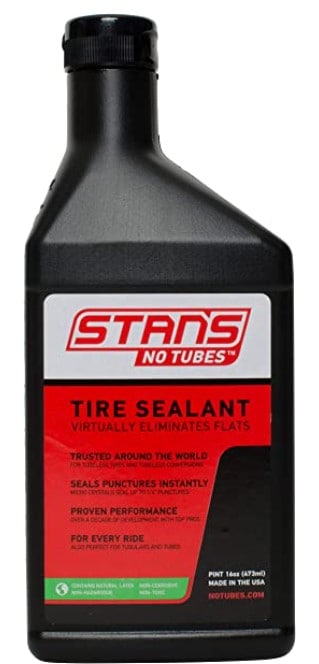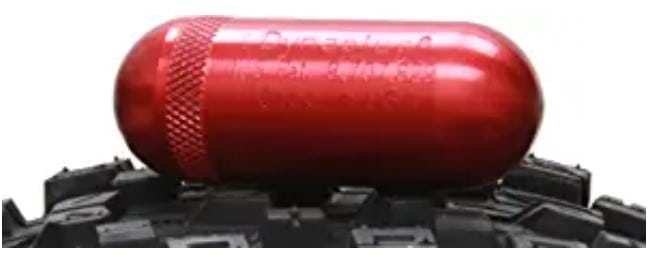Could you have heard about some of your buddies running tubeless tires on their MTB and wondered why? Well, the question you should be asking yourself is, “Should I go tubeless on my mountain bike too?”
You should consider going tubeless on your mountain bike because it comes with significant improvement in ride quality. You get better traction, less rolling resistance, better puncture resistance, and better rock crawling.
Consequently, tubeless tires tend to be cheaper than tube types in the long run.

Is It Worth Going Tubeless On MTB – What Are The Advantages?
So, is it worth going tubeless on your mountain bike? Sure, it is worth every effort.
Already, we have mentioned a few of the benefits of using tubeless tires but let us take a deeper look.
Some of the main benefits of tubeless tires include:
1. Ability To Run On Low Pressure
One of the significant advantages of tubeless tires is that you can run on low pressure. When running under high pressure, road vibrations are transmitted through the bike to the cyclist.
However, low pressure allows the tire to absorb most of the vibrations, which increases the ride comfort.
If you run on low pressure while using the tubed tires, you risk getting numerous pinch flats. On the contrary, you don’t have to worry about that when using tubeless tires.
2. Enhanced Puncture Resistance
Another benefit of going tubeless is that you will have better puncture resistance. Tubeless tires drastically reduce the chances of getting flats in the course of your ride.
First, with tubeless tires, pinch flats are a thing of the past. There are no inner tubes, so you don’t have to worry about pinch flats even when riding on low pressure.
In addition, since the tire will relatively be on low pressure, it remains flexible, saving it from some sharp objects. The tire will give in to most external pressures and flex instead of getting punctured.
3. They Are Self Sealing
This benefit is tied to the previous one but let’s take a closer look.
In place of a tube, tubeless tires have a liquid sealant in their inner cavity. Technically, the slime forms a self-healing skin inside the bike tire.
Notably, when small objects poke the tire, the escaping air carries the sealant as it gushes out. The rubber particles plus the liquid get trapped by the tire’s walls, thereby sealing the hole instantly.
As such, you may use a tire for a long time without ever mending a single puncture. It is only later when replacing the tire; you will realize how many flats tubeless saved you.
Remember to change the sealant every three or four months. If it overstays, it will get dry and ineffective. For you to get better results, you can go for NoTubes Tire Sealant, which is of high quality and it’s easy to use. Also, it resists freezing even in temperatures as low as -20°F.
However, if the hole is too big, the slime won’t seal. In that case, you will have to use the plug or get a new tire.

4. Better Traction
Since you don’t have to inflate tubeless tires hard, they will have a better grip on the trails. When riding off-road, you need maximum grip to the ground as the ground quality keeps changing.
Running low-pressure tubeless tires on your mountain bike gives you better traction on rugged terrains than tubed tires.
As a result, you will have better bike handling and braking experience even when riding in the rain or long descents.
Therefore, running on tubeless tires make cycling on the trails safer and efficient at all times.
5. Less Rolling Resistance
When you go tubeless on your mountain bike, you are likely to experience less rolling resistance.
With so many obstacles such as roots and rocks when riding off-road, low-pressure tubeless tires will reduce rolling resistance.
When the tire gets on obstacles, it slightly deforms upon impact and keeps you rolling.
With standard tires, the rocks and roots would either thrust you sideways or upwards, thereby inhibiting your forward drive.
What Are The Disadvantages Of Tubeless Tires?
Definitely, you would expect tubeless to have some drawbacks. They may not outweigh the merits, but they are worth mentioning.
1. They are Expensive
One major downside of tubeless tires is that they are more expensive than ordinary tubed tires. In addition to tire cost, you may have to change your rims too.
However, this shouldn’t discourage you from going tubeless on your mountain bike. In the long run, tubeless will save the cost of puncture repairs and buying new inner tubes.
2. Tubeless Are Not Easy To Fit
Fitting a tubeless tire on the rim is not as easy as fitting a tubed one. In fact, you should seek the services of a professional, or else you will damage the whole setup.
The tire fitting along the bead has to be firm and airtight. If you lack the skills, don’t risk damaging the rims.
3. Sidewall Puncture Concerns
One of the raw nerves for a tubeless tire is its sidewalls. A sidewall puncture can be catastrophic for a tubeless tire.
For the tube type, you can easily get away with it by changing the tube. But for tubeless tires, you have to get a new tire if you get a sidewall puncture.
All the same, sidewall punctures are rare these days since most manufacturers reinforce the walls to make them puncture-resistant.
4. The Danger Of Rim Damage
The other shortfall of going tubeless is the danger of damaging the rim if you ride on air with the air pressure too low. Although we said that you can ride on low pressure, it is always prudent to follow the manufacturers’ guidelines on inflation pressure.
With extremely low pressures, you risk damaging the rim as it will be hitting hard on obstacles.
Do You Need A Special Rim For A Tubeless Tire?
Having not to worry about frequent flat tires is a big relief to most mountain bikers. Well, we have been talking about tubeless tires, but do you need a special rim for you to go tubeless on a mountain bike?
Yes, just like you have to get tires made specifically for tubeless use, you will need to get tubeless compatible rims.
Most of these rims come either with rim beds that have no spoke holes or with a rim strip fitted. Surprisingly, you may be lost for choice if you went out looking for a tubeless compatible rim. In addition, the terminologies used could easily mix you up.
You will find terms such as tubeless, tubeless compatible, and tubeless-ready being used almost synonymously.
However, they are different.
The “tubeless” rims are the original MBT tire, and they follow the UST standards. The tubeless compatible and tubeless-ready do not follow these standards, but they also work well.
Actually, the UST-compliant rim is expensive and heavy, which makes most riders shun them.
Other frequently asked Questions
1. Do Tubeless Tires Go Flat?
Tubeless tires also got flat though it’s rare to get flats when you have the system in place. The slime inside your tire seals small holes quickly without your attention and keeps you going.
All the same, some holes are too big for the sealant to mend. Therefore, it is advisable to have a tubeless repair kit such as the Dynaplug Micro Pro Pill Tubeless Tire Repair Kit (Amazon Link) to help you take care of big holes.

2. Can You Run Tubeless Tires Without Sealant?
An original tubeless tire that conforms to UST standards can run without sealant. However, for tubeless-ready and tubeless compliant tires, you should always use slime to make them airtight.
3. How Long Does Tubeless Sealant Last?
Tubeless tire sealants can last anywhere between 2 to 6 months. It all depends on the environmental temperature and how many punctures you have had. Also, it will depend on the thickness of your tire casing.
Therefore, it is advisable to change the sealant every three months even if you haven’t had any major punctures.
4. How Much Does It Cost To Convert To Tubeless?
A tubeless conversion kit costs about $70. Actually, you can lower that cost by buying the components separately.
Also, the conversion cost will depend on whether your bike has tube-ready rims. If your bike doesn’t have tubeless compatible rims, you will have to spend more buying a new wheelset.
5. Why Do Pros Not Use Tubeless?
Most pros do not use tubeless tires due to the shaky safety and usability standards associated with tubeless tires. Notably, not all manufacturers adhere to the international standards for tubeless tires and rims.
All the same, with the entry of the UST, we might see more professional cyclists going tubeless.
Also read:
Final Take
So you had been asking whether you should go tubeless on your mountain bike. To this end, we have discussed a lot, especially the benefits of tubeless tires.
For your mind to be at peace as you ride through the trails, going tubeless could be the best decision for you. You will suffer no more pinch flats or flats due to small thorns on the course.
If you own a new MTB, it most likely has tubeless-ready rims and tires. In that case, converting to tubeless shouldn’t cost you a foot and a leg.